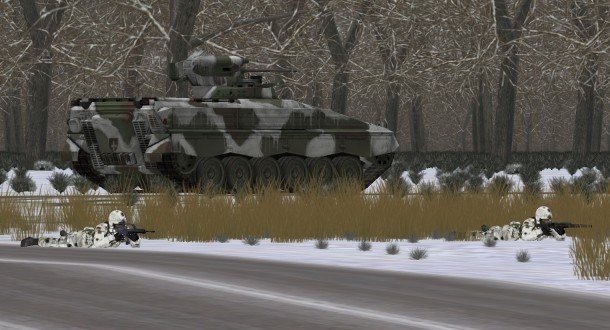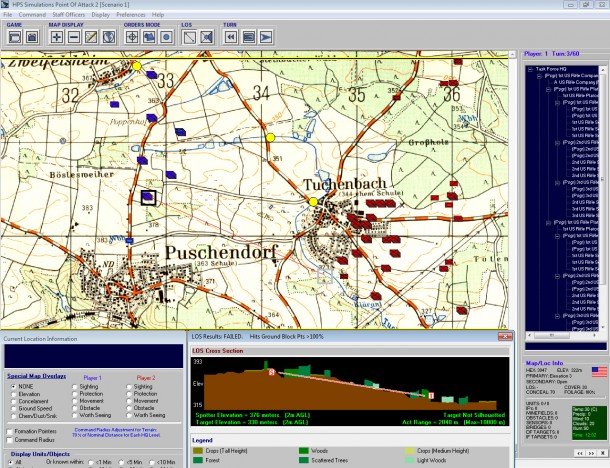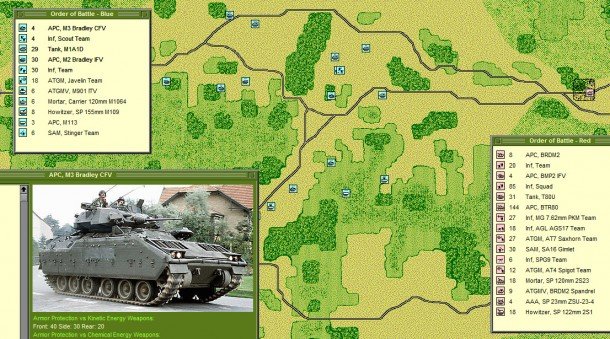
This feature originally appeared in issue 247 of PC Gamer UK.
While a PC Gamer Editor's Choice logo on the front of a wargame or simulation box might be a cast-iron Fun Guarantee, it doesn't mean you're about to purchase a product that will help you understand or stay alive on a modern battlefield. To be sure of that you need to seek out one of The Camo Club – the select band of titles so steeped in realism, today's armies use them as training tools.
The men with the buzz cuts and big pockets began utilising videogames back in the early '80s. One of the first recruits was arcade classic Battlezone. Struck by the parallels between hunting vector-graphic hover-tanks and UFOs in a 3D battlespace, and hunting T-72s and Hind gunships on a Cold War battlefield, the US Army persuaded Atari to adapt their coin- op for instructional purposes. Two 'Bradley Trainers' were eventually built. Featuring 20th century targets and weapons, and AFV-style control yokes rather than joysticks, the machines were designed to assess and sharpen the skills of Infantry Fighting Vehicle gunners – a fact that could explain why movement options were restricted to turret traversal.
Today's military classrooms are awash with PC-based games. Cheap and convenient compared to field exercises, versatile 3D simulations and map-based strategy titles are helping teach our troops to do everything from pilot aircraft and operate tanks, to lead infantry platoons, plan counter-insurgency operations, and organise logistics. Those careworn warriors on the evening news – the ones dashing from Chinooks, crouching behind mud walls, or poring over laptops in tented HQs? At some point in their careers, they've probably sat in front of a monitor wondering whether to push on, pull back, or check GameFAQs for a walkthrough.
A few higher-ranking American students may well have encountered James Sterrett during their warfare education. James, the deputy head of the simulations division at the US Army Command & General Staff College, Fort Leavenworth, Kansas, spends a significant portion of his working life in the company of publicly available PC wargames like Decisive Action, Combat Mission: Shock Force, and Future Force. While many of the games he employs will be familiar to recreational grognards, the manner in which he employs them might come as bit of a surprise.

Decisive Action is used to run gruelling division-level staff exercises. Of a class of 64, 50-54 will form a division staff, while the rest either step into the combat boots of brigade commanders, roleplay big fish in the Joint Task Force, or act as event overseers. Things start gently with preliminary planning intermingled with six weeks of general coursework. The crucible-hot crescendo is the three days of final planning, the 3-4 days of actual fighting, and the follow-up half-day of unflinching AARs (After Action Reports). “By this point,” says James “the students are exhausted. They have typically fought a battle lasting 24-36 hours in the sim.”
There are no sly restarts here, no banishing embarrassing results with a swift click of a mouse. “Military AARs are often a brutal catalogue of each person's failures – and how they should have avoided them. CGSC is not especially harsh by Army standards... Officers have been known to break down in tears at places like NTC (National Training Centre) – but it's better than not fixing those failures and consequently having to write letters home to dead soldiers' mothers.”
The biggest gaming news, reviews and hardware deals
Keep up to date with the most important stories and the best deals, as picked by the PC Gamer team.
As well as searchlighting the flaws of individual personnel, PC wargames and sims are also adept at exposing organisational and equipment weaknesses. In 2007/8, Point of Attack 2 was used by the Centre of Army Analysis to simulate the so-called Catastrophe Scenario. If a hostile non-national force gained control of a nuclear weapon, how best could the US neutralise that threat? The game modelled every aspect of the nightmare from the detection of the device to the ensuing combat action by air, ground and special forces. Insights gained were never discussed openly, but apparently included changed thinking on UAV use and the risks of using HE close to nuclear weapons.
At roughly the same time PoA was storyboarding Tom Clancy's next eight novels, it was part of a project analysing the US Army's bold Future Combat System modernisation programme. Its sophisticated communications modelling showed up potentially disastrous problems with network capacities. In the heat of battle the traffic generated by a host of new hi-tech radio and GPS-reliant equipment would – unless steps were taken – lead to crippling comms collapses.

These examples are just the tip of a multi-million dollar usage iceberg, if the scant available information is to be believed. eSim, the engineers behind modern armour marvel Steel Beasts Pro, have an unusually impressive customer list (see over) and a controversially high pricing model, but even so, it's startling to hear director Nils Hinrichsen admit that only 5% of the company's turnover comes from sales to gamers.
Naturally, government customers expect a little more for their money than the average punter. For Major Holdridge, the one-man-band behind classroom staple TacOps, a new contract invariably meant additions to the selection of units, vehicles and weapons. Sometimes other changes were required too. When TacOps joined the Canadian Army, the major found himself implementing a dual French/English interface. When it was seconded to the US Marines, requests led to representations of night fighting, combat engineering and beach amphibious assault being bolstered.
And there are other drawbacks to crafting for the pros. While the major describes occasions when contracts were “little more than a paper handshake,” he also experienced suffocating bureaucracy and civilian project managers “whose primary duty seemed to be to squelch input from military users/testers so as to prevent the intrusion of dangerous bright ideas not included in the original specification.” Perhaps those never-satisfied forum regulars aren't so bad after all.
Wondering why the next patch for Armor Platoon VII or Falcon Ace is taking so long? There's a chance the folk making it have been distracted by War Work. Before dashing off another 'Where's the update?' messageboard tirade, remember that without those distractions Armor Platoon VII or Falcon Ace might not exist, and, possibly, your brother/sister/mate in the forces might be a less capable soldier.
Be thankful too, that in a world where cutting-edge military hardware is eye-wateringly expensive and understandably inaccessible, much of the latest and greatest military training software is just a modest PayPal payment away.
Continue for a look at some of the most popular military sims in service today.

